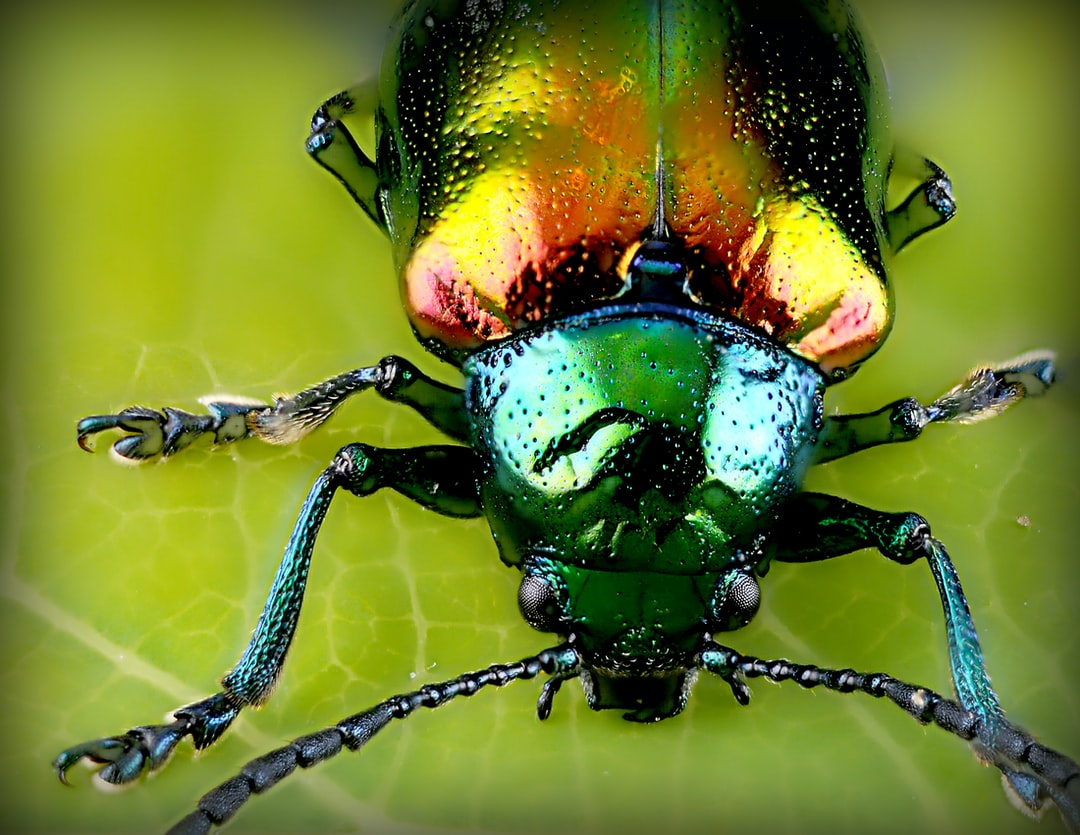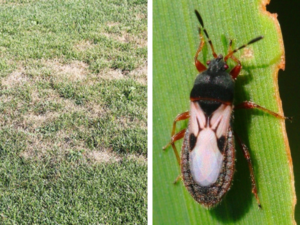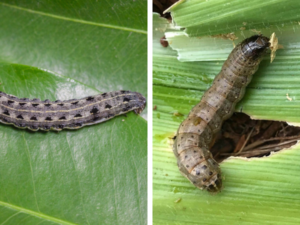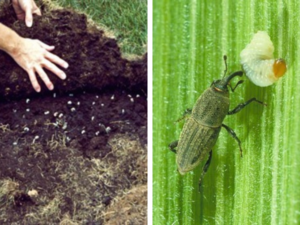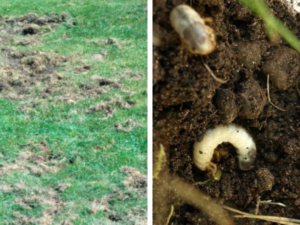If you’re noticing patches of dead grass in your lawn, it could be any number of common lawn pests. I know from personal experience that trying to figure out what’s causing the damage and how to get rid of these common lawn pests can be a frustrating process.
But don’t despair!
In this blog post, we’ll take a look at some of the most common lawn pests so you can identify what might be eating your grass and take steps to get rid of them.
Common Lawn Pests
There are many different types of insects and animals that can damage or destroy a lawn. The most common include grubs, sod webworms, chinch bugs, cutworms, and armyworms.
These insects, if left unchecked, can wreak havoc on a yard. Click To Tweet
Lawn Insects Damage Your Lawn
If you notice your turf beginning to turn yellow in patchy areas, it is likely due to chinch bugs. As they continue to feed, the turf will dry out, turn brown, and appear to be suffering from drought stress.
The tiny, yet mighty, Chinch Bug is among the most destructive common lawn pests that plague lawns. The adults are roughly the size of a lead pencil and feature an “hourglass” shape on their backs.
Chinch bug infestations are quite common during the warmer months, when they can be seen swarming in large groups. They feed on the grass by sucking out its moisture and nutrients, and in severe cases, can weaken and kill the grass.
These pesky critters can wreak havoc on your lawn if left unchecked.
Damage frequently appears from early July through late August when the insects are actively feeding. Chinch bugs often go unnoticed in turf grass until damage becomes visible.
The best time to look for them is during hot, dry weather from early July to late August. Chinch bugs feed on grass, causing damage that is most noticeable in areas with thick thatch that are exposed to full sunlight.
If you see damage appearing on your plants in early July through late August, it is most likely due to chinch bugs feeding on them.
Insects love your lawn almost as much as you do, and if you aren’t careful they can do a lot of damage that’s challenging to repair. Unless you are an entomologist (a bug scientist), insects may not be your thing.
However, it’s important to be aware of a few things about them so you can take the necessary steps to keep them away.
There are two main types of lawn-eating insects: those that feed on the surface of the grass, and those that feed on the roots. Surface-feeding insects are easy to spot when you inspect your lawn, but subsurface insects can be more difficult to detect and control.
Sod Webworms Damage

(Source)Grass damage usually starts with small, irregularly shaped patches that go from green grass to dead, browned turf. The damaged areas expand quickly, and the grass often turns a straw color.
Sod Webworms are small, brown moths that are usually most visible when you are cutting your grass.
Sod-Webworms are small, brown, and flightless. They fly in a zigzag motion, and are most visible when you are cutting your grass.
The adult Sod-Webworm does not do as much harm as the larva, which feeds on lawns. Sod-Worms feed during the night, and the damage they inflict is covered up by the new blades of lawn.
Lawns usually become infested when it goes dormant.
The first sign of a web worm problem is small, torn-up, and browned areas in the lawn.
As the web worms continue to feed, the damaged area will widen and merge. If there is a lot of sod-web worm activity, a large area of grass can be denuded or killed off during the heat of summer and droughts.
Sod-Webworms are the worst pest for your lawn during the summer.
Cutworms and Armyworms
A cutworm is a type of caterpillar that loves to eat plants, and is especially fond of eating seedlings and seeds.
Army worms and corn earworm are large, green, and fuzzy caterpillar that feed on grass, leaves, and fruits. These insects are not usually a problem in lawns and gardens, but can become so if their population explodes.
When their populations swell to astronomical numbers, swarms of locusts leave no leaf unturned as they devour every blade of grass in sight.
The name “Army Worm” actually comes from the behavior they exhibit: marching across the lawn, destroying everything in their path.
Cutworms are a pest that feeds on crops by attacking their stem and root. They’ll chew through the stalk of the plant, causing it to topple over. To spot this, look for a fallen crop with cuts around the base.
If plants have been recently pruned, check for any that have been chopped off at the base.
If the stems have been eaten away, this may indicate the presence of pesky, worm-like pests called “cutworms.” Cut worms tend to chew off the ends of young seedlings, so look for signs of damage on the underside of leaves.
Billbug Inspection Under Lawn
A close-up of a bill bug.
These common lawn pests spend the winters lying in wait in piles of leaves in your lawn. Then, when spring arrives, they return to lay their eggs in the stems of your plants and grass.
The newly hatched larva, called “grub,” is whitish in color and lacks legs. It feeds on the plant’s roots, which will eventually kill the plant.
The adult Billbugs emerge in warmer months, and begin to feed on grasses, shrubs, and trees. The damage they cause to lawns and turf is noticeable as the grass turns brown and dies.
If your yard is starting to look unhealthy, and you notice your grass and plants appear to be hollow, you may have a Billbug infestation. These common lawn pests feed on the stems, crowns, and thatches of grasses, and can also damage the roots, as well. To eliminate these insects, use an insecticidal spray on your yard.
If you find any damage to your yard, especially to your lawn, then it may be a sign that you have a Billbug problem. The damage caused by these insects is easy to spot, with symptoms like discoloration, wilting and thinning of grass and, eventually, death.
White Grubs in the Lawn
Adult beetles emerge to breed and lay eggs. They feed on the roots, killing the grass.
Grubs, or larval forms of various beetle types, are white in color. These common lawn pests are best known for eating away at the grass’ roots.
As the weather gets colder, some common lawn pests will burrow underground to avoid freezing. When it gets warmer, these common lawn pests will resurface and resume feeding on grass. This underscores the need for consistent pest control.
If your yard is suffering from brown or dead spots, it may be caused by White Grubs. These insects chew on the root systems of your lawn, preventing it from absorbing water. To determine if this is the case, pull up the damaged turf and look for severed roots.
If you’ve noticed patches of dead grass in an otherwise healthy lawn, there’s a good chance you have an infestation of insects called “grubs.” These small, whitish worms eat away at the roots of your grass and cause significant damage.
Treatment and Control
A thriving, healthy, and well-maintained yard can support numerous types of insect life, but at some point, the damage caused by these common lawn pests will become noticeable.
There are ways to deal with pest issues once they’re discovered, and there are preventative measures to take if you’ve noticed a yard or area in your neighborhood has a problem with a certain bug, such as Japanese beetles.
To learn about protecting your yard from damaging insects, contact the experts at Triguard.
How do I identify common lawn pests?
The best way to identify what kind of common lawn pests you may be facing, is to take a sample of the affected area to your local cooperative extension office. They will be able to help you identify the pest and give you recommendations on how to control it.
What common lawn pests could in my grass?
There are many different types of common lawn pests that could be in your grass, including but not limited to: ants, beetles, caterpillars, crickets, earwigs, grasshoppers, and millipedes. If you are concerned about a specific type of bug infestation, it is best to consult with a local pest control expert.
How do you get rid of common lawn pests?
There are a few ways to get rid of common lawn pests. You can either manually remove them, use a pesticide, or use a natural method. If you choose to manually remove the pests, you will need to identify what type of pest it is and then find the appropriate method to remove it.
For example, if you have grubs, you will need to dig them out of the soil. If you have moles, you will need to trap them. If you choose to use a pesticide, be sure to select one that is specifically designed for the type of pest you have.
You will also need to follow the directions on the label carefully in order to avoid harming your lawn or yourself.
If you prefer a natural method, there are many recipes available online for homemade pesticides. You can also try using beneficial insects such as ladybugs or lacewings to eat the pests.
What’s eating my grass?
There are many potential causes for grass that is being eaten. It could be due to a lack of nutrients, pests, or even a disease.
If the grass is being eaten by an animal, it is important to figure out what type of animal it is so that the proper steps can be taken to prevent it from happening again.
If the grass is being eaten by insects, then it is important to identify the type of insect and take steps to get rid of them.
Conclusion
If you think you might have a problem due to some of these common lawn pests, the best course of action is to contact a professional. They will be able to identify the specific pests and recommend the best treatment options.
In the meantime, there are some things you can do to try to control the damage.
First, make sure your grass is healthy by mowing it regularly and watering it deeply but not too often.
Second, remove any potential food sources like fallen leaves or debris from your yard.
Finally, keep an eye out for signs of infestation so you can take steps to get rid of them as soon as possible.

